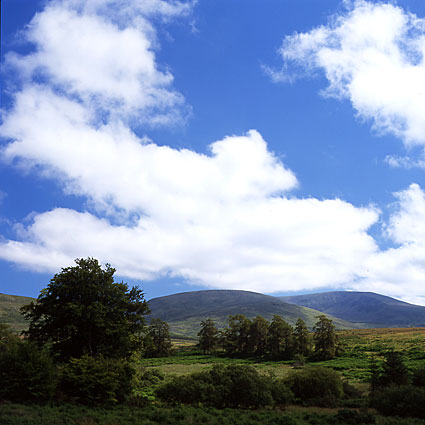

Landscape is a theme many photographers love. Even people who wouldn't think about themselves as photographers take a camera when they go out walking or at least during their holidays. The landscape is often beautiful, it is quite easily approachable and constantly changing during the day and the year.
But what is 'landscape'? And why do people make photographs of it and hang them on the wall?
These are some of the questions I like to address in this article.
Disclaimer: all comments I make about 'culture', 'why people make photographs' etc. are coarse generalizations. Inevitable given the character of this introduction, but coarse nevertheless.
Landscape [ 1 ] could be described as a combination of geological, biological and culture-historical elements, forming a unity in a certain area as one vista. In other words: an area enclosed by the horizon. [ 2 ]
This definition shows that landscape - in opposition of e.g. a zoological habitat or governmental district - is a visual notion. It is visually perceived space. [ 3 ]
And it is not limited to the natural environments of plant and animal. Human activities and their consequences are - a fact I like to stress - part of most landscapes.
Is town part of the landscape as well? As a consequence of the definition it is, but is generally not regarded as such. In my opinion this has to do with the lack of a real horizon in built-up areas - there are always buildings in front of it.
Since photographically landscape and street are different genres, I leave town out of this article from now on.
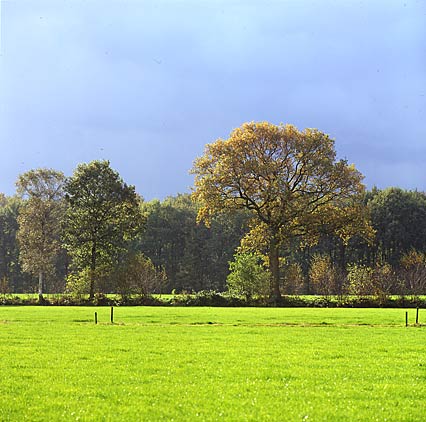
As I said, landscape is a visual notion. A landscape is not only about space - it is about time as well. You can only perceive at a given moment. (Compare this to 'district' - that is about space and government, not about time.)
This has the consequence that weather is part of the landscape by definition. The landscape is never without weather - although that weather is always changing.
The landscape is never without season as well. It is either winter, spring, summer or autumn.
Weather and time are an inescapable part of the landscape. In other words: the landscape is never without the particular light of that particular moment.
And season is important as well. Just look at the colours, the height of the sun, the
activities of the landscape's inhabitants.
In the history of art landscape had more attention in one period than in another. In some ages, like Renaissance and in the Dutch 17th century, a lot of painters were doing landscapes, whereas in other times, like the Middle Ages, the genre played no part on its own. After Classicism the age of Romanticism puts landscape back to the fore. Last century landscape popularity waned again.
To make things even more complicated, the emphasis of attention changed considerably during these periods. Romanticism loved the landscape for others reasons than Dutch painters like Vermeer en Ruysdael.
The way landscape plays its part - or doesn't - has a lot to do with the way a certain culture experiences its landscape. Is it thought of as an opposition to culture - or as a necessary counter-balance? Or is there a lack of awareness of the landscape anyway?
The outline below can only be very brief, but it is important for photographers as well to know a bit about the history of this genre.
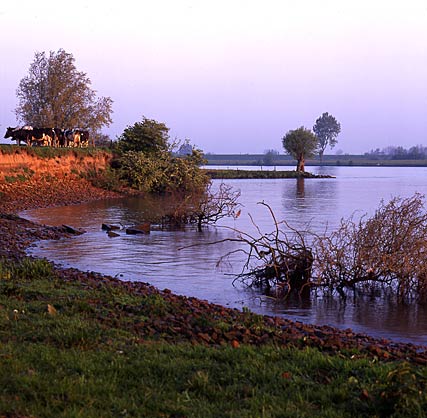
Generally speaking man wants to acquire his environment. As a hunter-gatherer he didn't have that much influence on his surroundings, but he was very dependant on it. This attitude towards acquisition changes as he begins to be a farmer and cattle-breeder. He does not only live in the landscape but he forms it as well. Nature is his ally and enemy alike as he still is dependant on the fertility of the land, on rain and sunshine.
At the very moment people settle in cities rather than living and working with the landscape, they become aware of that very landscape. Because man no longer is automatically a part of that landscape, he can look at it as such for the first time. Since the Renaissance landscape has a place of its own in the arts.
The ways the landscape is seen is largely divergent. On the one hand there is interest from the men of science, who want to discover and chart new worlds. On the other hand there are
travelers (and their democratized off-spring: tourists) looking for peace, beauty and awe.
Nature and landscape has been variously appreciated, from the possibility of
exploitation to refuge for souls who need to escape the busy and ever changing place called town.
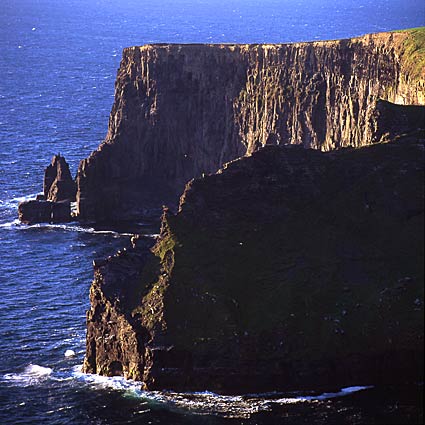
In the world of photography this spectrum of approaches is clearly visible. Photography maps the world,
publishes so to speak the landscape and make it
accessible to everyone.
At the same time photographers looked for and caused highlighting the mystic of the foreign landscape. Although (or because) photography seems to be objective it has a enormous suggestive power. It offers with its images of paradise like beaches and wild mountains a counter-balance for everyday greyness many feel they live in.
And exactly this brings us to the paradox of landscape photography. In its realism and detail it maps the world and at the same time offers a refuge for those who want to escape their world.
At least one thing both sides of the coin have in common: present-day people are no longer immediately linked the landscape they live in. They live and work in town. At the same time they are more aware (which is not the same as understanding!) than ever of the landscape - and aware of the innumerable amount of landscapes of this world, beautiful and ugly, horrifying and tranquillizing. Landscapes that, on top of that, could all be visited by them.
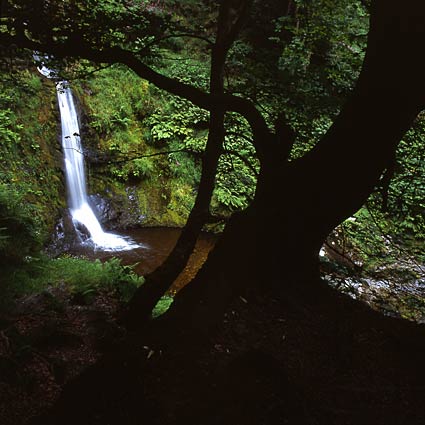
Some landscapes have been more pleasing to mankind than others. In agricultural societies fertility and climate play an important part here.
Nature could only be appreciated from the moment it was no longer threatening to men. Therefore it was not until the age of Romanticism that people for example started to climb mountains and until halfway the twentieth century before people began to understand the own beauty of wetlands and moors.
Nowadays those landscapes are often loved for being in exact opposition to the own urban environment: wilderness and few reminders of modern culture.
Within this framework some places have something magical, something intriguing to most people - like waterfalls, particular rock formations. Islets and the coast with its surf and tide. Places that are immediately linked to our ancestors, like castles and megalithic tombs.
These magical places have much in common: they are all about borders. Borders between land and sea, between now and then, between nature and culture. And this is not only the case with places! Special moments are often on the border of day and night or in the opposition between sunlight and a coming storm.
I guess people are attracted to these border places and times. Which is also true within literature - how many poems and novels are written about coming of age or about dying?
It is exactly at these borders, lands of transition and places of opposition, that the symbolic value of the landscape is strongest and comes near to the ancient and everlasting themes of humanity: birth, coming of age, love and hatred, success and failure and in the end death.
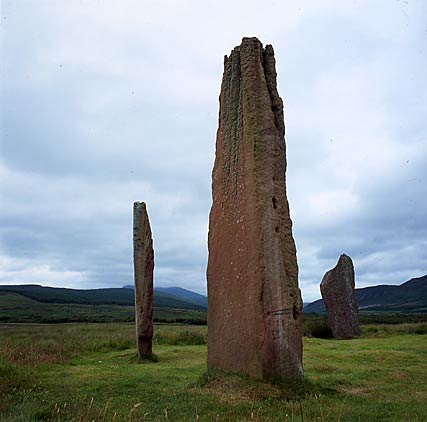
I already discussed the fact that mankind has had a vast influence on the landscape. But of course this differs from country to country and place to place.
Within the Netherlands there is actually no area that is not influenced by people - not even the Waddenzee. Within Europe one has to go high into the mountains or to the very north of Scandinavia or some very small isles to meet and see an untouched landscape.
Elsewhere this may be different. Although the earth is being conquered, used and wasted by men at an enormous speed, there are some large areas in for example Australia or the United States, relatively well protected, that can be seen as original landscapes. Though tourism and pollution levy their toll here as well.
The fact that European landscapes are heavily influenced by men causes a difference between most European nature & landscape photographers and those out of the United States or Australia. In these countries landscape photography has still something of the magic of the discovery of new territory where no one ever set foot - although actually countless photographers have been there before you. There the landscape is still symbol of the magic unknown, a land of endless possibilities.
That is why Antelope Canyon, Yosemite, Ayers Rock etc. have become icons of the unshakeable nature and at the same time of unlimited
possibilities offered by the land to mankind.
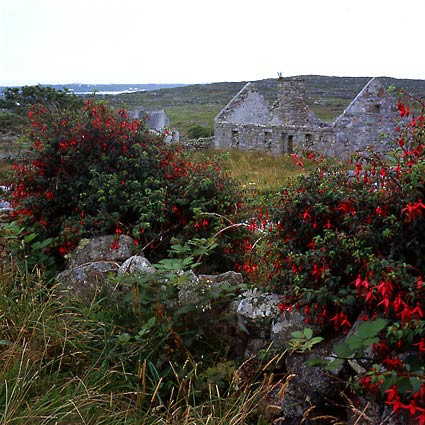
Landscape photography in Europe is almost by definition photography of a cultural landscape. This has its own magic, with stone circles, castles, farm houses. But is still is a landscape influenced by men. Photography will always be mapping the own, already known world.
Landscape photography in Europe has less of an icon character than e.g. in the United States. The landscape does not reflect an open future to be welcomed with trust, but is rather image of a rich past and an area full of difficult challenges.
I have to say here that many photographers approach the Scottish scenery or West European forests as if it has never been touched by people. But the opposite is the case (take a look at my article backgrounds of the Scottish and Irish landscapes).
Disclaimer: I no way I want to claim superiority for one of both photographic traditions! The way I describe them is very generalizing anyway, but it does express the differences between American and European landscape photography as I experience it.
More about different approaches to landscape photography can be found in the A stunning sky article.
In the about the photographer section I tell more about my personal motivation for landscape photography.
1: The word 'landscape' comes from Dutch 'landschap' out of the Dutch painting school of the 17th century.
In Dutch it was another word for 'area' of 'county', but painters used the word as a name for the genre.
2: Of course the horizon is not always a visible feature in a landscape photograph, especially the more intimate portrait of a landscape (see also my article: on focal length).
3: Arguably smell and sound can be considered part of the landscape as well, making it a notion including all senses.
I borrowed many thoughts in this article from the fascinating book filosofie van het landschap by Ton Lemaire (Bilthoven, the Netherlands, 1970).
I like to thank all people who commented on this article and make me think again. I added a few thoughts in the notes above as well as both disclaimers.
This article is written by Wim van Velzen, © 2003.
Comments on the article and photographs are welcome!The landscape photographs shown here and lots more are put in several portfolios!
It is also possible to order landscape prints or to use them editorially or commercially.